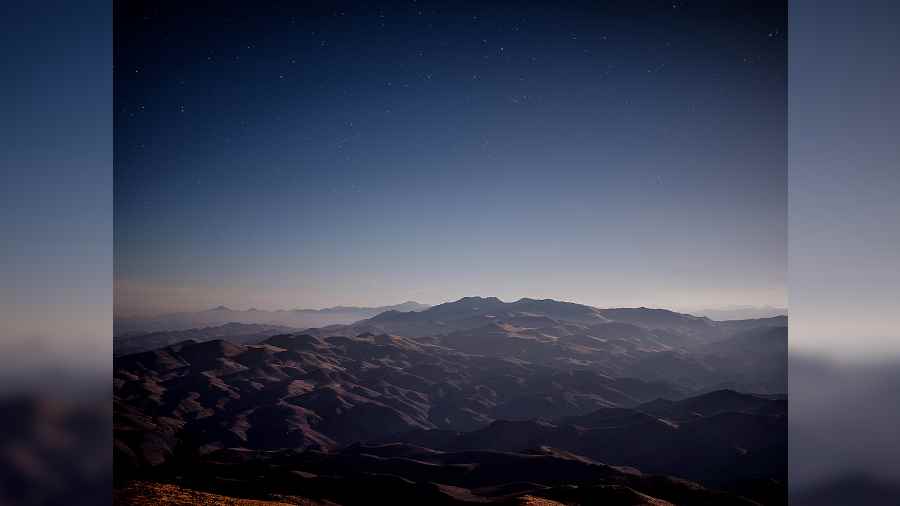The Atacama, on a plateau high in the Chilean Andes, is one of the driest and darkest places in the world. At night, calm, unruffled winds off the Pacific Ocean produce some of the most exquisite stargazing conditions on Earth.
One evening in late January the sky was so thick with stars that the bones of the constellations blurred into the background. The Milky Way, our home galaxy, was rolling straight overhead, and the Large and Small Magellanic Clouds, satellite galaxies of our own, floated alongside like ghosts. The Southern Cross, that icon of adventure and romance, loomed unmistakably above the southern horizon.
In the last half-century, astronomers from around the world have flocked to Chile and its silky skies, and now many of the largest telescopes on Earth have taken root along a sortof observatory alley that runs north-south for some 800 miles along the edge of the Atacama.
The residents include the Very Large Telescope, composed of four telescopes, each more than 8 metres (27 feet) in diameter, and built by an international collaboration called the European Southern Observatory. The Vera C. Rubin Observatory, another 8-metre telescope, is set to start operating next year, mapping the entire sky every three days.
Las Campanas Observatory, whose telescopes and offices are strung along a steep ridge on Cerro Las Campanas at an altitude of 8,500 feet, was one of the early adopters to the Atacama sky. Taking pride of place along the ridge today are two innovative telescopes, the Twin Magellans, each with curved sweeps of aluminised glass 6.5 metres in diameter, side by side in separate enclosures.
But these are just the beginning. Las Campanas is an outpost of the Carnegie Observatories, based in Pasadena, California, US, which in turn is owned by the Carnegie Institution for Science, based in Washington, US. The Carnegie Institution is a founder of and a driving force behind a consortium of 13 universities and institutions that aims to build the Giant Magellan Telescope, or GMT, a multibillion-dollar instrument more powerful than any existing ground-based telescope.

When completed, the telescope will have seven mirrors, each 8 metres in diameter, that togetherwill act as a 22-meter-diameter telescope, roughly 20 times as powerful as Palomar. The GMT will be built at the top of Cerro Las Campanas, 2 miles from the domes of the Carnegie’s existing telescopes.
Next to the domes on Las Campanas is a cluster of cabins for visitors, staff members and researchers. The white domes of La Silla Observatory are visible to the south. Attached to the main lodge is a terrace where, at day’s end, astronomers gather to try to get a glimpse of the green flash, a rare last vestige of the sun as it disappears below the horizon, if the conditions are exactly right.
One night I walked over to the Swope Telescope, beneath a Milky Way so bright that it was possible to navigate the narrow trail by its light alone. Through the telescope I beheld banded Jupiter holding court with three of its glittering moons and, 1,60,000 light-years away in the Large Magellanic Cloud, mists of interstellar gas twining through the Tarantula Nebula.
The view at the top of Las Campanas the next morning was less immediately celestial: a cluster of construction trailers; a maze of rope barriers. Concentric circular trenches, some as much as 60 feet deep, had been carved into the volcanic rock of the mountaintop, bringing to mind a pre-Columbian earthwork. This was the future home of the Giant Magellan Telescope.
Grand Magellan instruments are being prioritised for studying exoplanets, they would be capable of detecting rocky, Earthlike planets as far as 30 light-years away. Moreover, as technology improves over time, astronomers will be able to change and upgrade the main instruments, whereas space-based telescopes are stuck with whatever technology they carried at launch.
In a briefing down in one of the construction trailers, Oscar Contreras-Villarroel, the vice-president of the Grand Magellan organisation and its legal representative to the Chilean government, elaborated on the GMT’s capabilities. The design includes a sophisticated adaptive-optics system to compensate for atmospheric turbulence that can blur celestial details (and make stars twinkle). And some of the mirrors will be able to adjust their shape 2,000 times a second, to keep star images crisp over a field of view two-thirds the size of a full moon. (The Webb telescope’s field of view is only one-tenth of a full moon.)
The first of the Grand Magellan mirrors was cast in 2005 beneath the University of Arizona’s football stadium, in a rotating furnace developed by J. Roger P. Angel, an Arizona astronomer, as a way to build giant mirrors. Three of the mirrors are nowcompleted and sit in boxes at the Tucson airport. Three more are being polishedand tested. The seventh and final mirror is set to be cast this year.
Depending on funding, the telescope could begin operations in 2030, Isaacs said in an email.
The peak of Las Campanas was blasted flat in 2012 to make room for the telescope, which will be almost as big as a football stadium and more than 22 stories high.
Miguel Roth, a former director of Las Campanas, led an up-close tour of the foundation. It had taken nine months to excavate, at times by hand, he said, to avoid using explosivesthat might fracture the underlying rock. Giant ball bearings will insulate the telescope from earthquakes. The telescope building, a giant rotating cylinder,has been designed with a system of vents and windscreens to keep the temperature inside constant. Moreover, all heat-producing machinery will be underground and downstream from the prevailing wind, thwarting thermal air currents that could affect the sensitive mirrors.
“The telescope is to be one with the mountain,” Roth said. “We’ve got one of the best sites in the world, if we don’t screw it up.”
NYTNS










